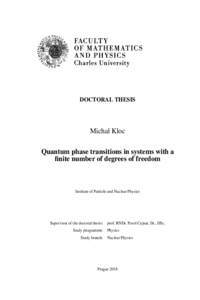Quantum phase transitions in systems with a finite number of degrees of freedom
Kvantové fázové přechody v systémech s konečným počtem stupňů volnosti
dizertační práce (OBHÁJENO)

Zobrazit/
Trvalý odkaz
http://hdl.handle.net/20.500.11956/102419Identifikátory
SIS: 136207
Katalog UK: 990022035880106986
Kolekce
- Kvalifikační práce [11978]
Autor
Vedoucí práce
Konzultant práce
Stránský, Pavel
Oponent práce
Schaller, Gernot
Šindelka, Milan
Fakulta / součást
Matematicko-fyzikální fakulta
Obor
Jaderná fyzika
Katedra / ústav / klinika
Ústav částicové a jaderné fyziky
Datum obhajoby
18. 9. 2018
Nakladatel
Univerzita Karlova, Matematicko-fyzikální fakultaJazyk
Angličtina
Známka
Prospěl/a
V disertační práci studujeme a klasifikujeme kritické jevy v rozšířeném Dickeho modelu (EDM - extended Dicke model), který popisuje interakci mezi dvouhladinovými atomy a monochromatickým fotonovým polem (schematický model tzv. kvantové elektrodynamiky v optické dutině). Tento model patří do třídy tzv. konečných modelů, jejichž počet stupňů volnosti f zůstává konstantní nezávisle na velikost systému N. Důležitou vlastností těchto systémů je, že termodynamická limita N → ∞ odpovídá limitě klasické ħ → 0. Toto nám umožňuje studovat semiklasickými metodami mnohé kvantové kritické jevy, zejména pak kvantové fázové přechody (QPTs - quantum phase transitions) a kvantové fázové přechody excitovaných stavů (ESQPTs - excited-state quantum phase transitions). Za použití semiklasického přístupu identifikujeme a klasifikujeme QPTs a ESQPTs v rozličných režimech EDM, přičemž výše zmíněné jevy uvedeme do souvislosti s termálními fázovými přechody. Studujeme kvantovou provázanost jak pro základní stav, tak pro stavy excitované, jako funkci interakčního parametru mezi atomy a polem. V integrabilní verzi EDM uvedeme do souvislosti ESQPT a monodromii a diskutujeme efekty na klasickou dynamiku. Pozorujeme "rozpad" monodromie při neintegrabilní poruše systému. Dynamické důsledky ESQPTs jsou testovány pomocí kvantových "kvenčů"...
In the thesis we investigate and classify critical phenomena in the extended Dicke model (EDM) which describes the interaction between two-level atoms and a single-mode bosonic field (schematic model for cavity quantum electrodynamics). The model belongs to the class of so-called finite models, which keep the number of degrees of freedom f constant independently on the size of the system N . The important property of these systems is that the thermodynamic limit N → ∞ coincides with the classical limit ħ → 0. This allows us to study various quantum critical phenomena, in particular the ground-state quantum phase transitions (QPTs) and the excited-state quantum phase transitions (ESQPTs), by means of semiclassical methods. Using the semiclassical approach we identify and classify the QPTs and ESQPTs in various settings of the EDM and make a link to thermal phase transitions. We study the entanglement properties of both the ground state and the excited states as a function of the atom-field interaction strength. In the integrable version of the EDM we make a link between the ESQPT and monodromy, and discuss its effect on classical dynamics. The fate of monodromy under a non-integrable perturbation is observed. The dynamical consequences of the ESQPTs are examined using quantum quenches. The influence of the...
